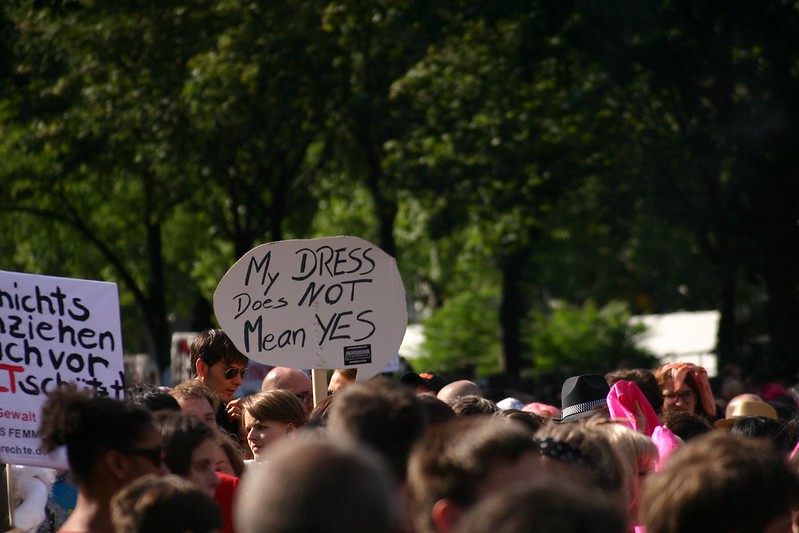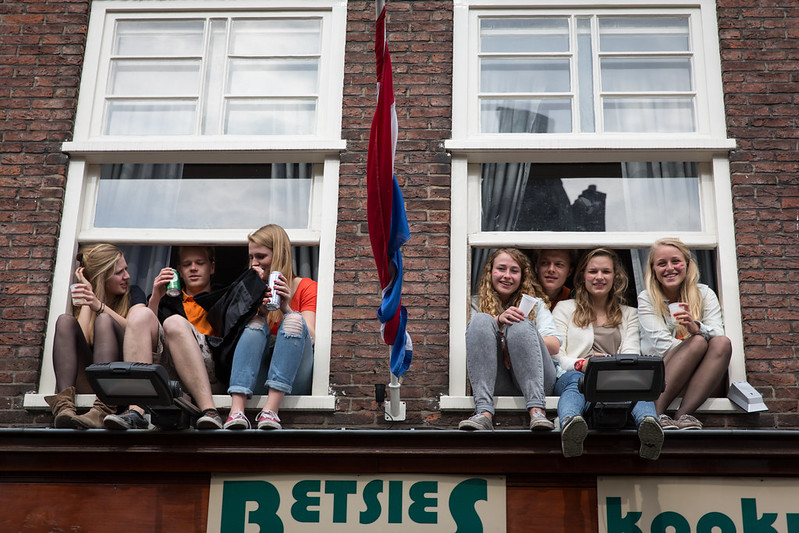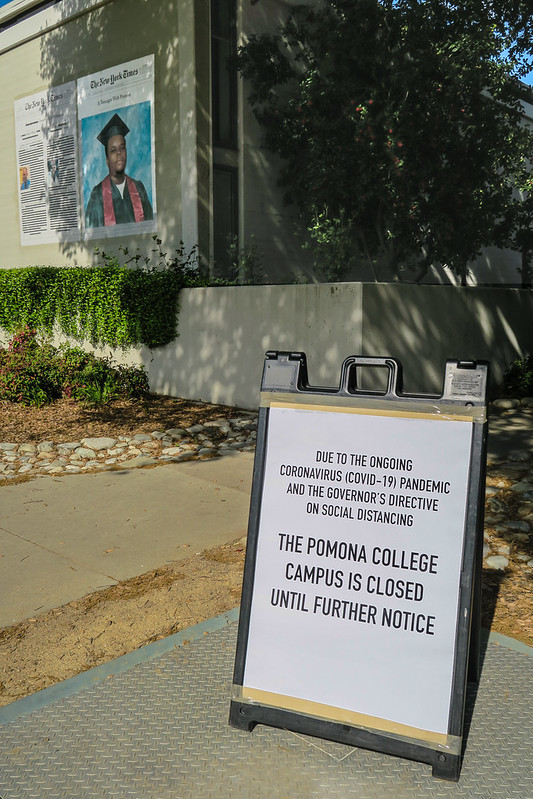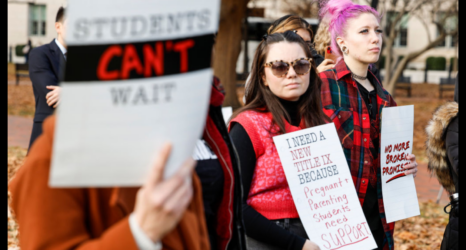
Unlike Aprils past, Sexual Assault Awareness Month (SAAM)’s standard awareness marches, SlutWalks, clothesline projects, restaurant fundraisers, and other crowdfunding drives to support services for survivors have disappeared as social distancing and stay-at-home orders have rightfully been implemented across the country to help contain COVID-19.
Although SAAM isn’t what it has been in the past, advocates in the field are doing what they can—webinars for online organizing around SAAM are springing up daily, countless SAAM events are being re-imagined as online actions for the first time ever, and on the SAAM Day of Action, April 7, advocates shared teal selfies to keep the light of SAAM shining in digital spaces.
Although some digital awareness and support campaigns continue this April, the necessary loss of public SAAM activities is occurring just as the pandemic is increasing many of the environmental and social conditions that facilitate sexual assault.
In this context, campus administrators must take concrete steps to protect vulnerable students—grounded in the abundance of evidence that reveals what works.
College women are at a high risk for sexual victimization, and, under typical circumstances, one in four women is sexually assaulted in college.
SAAM is usually an annual opportunity for outreach and consciousness-building; however, many schools’ sexual assault response and prevention obligations have fallen by the wayside as administrators struggle to address other pressing needs.
Although campuses have largely closed to protect students from COVID-19, many who cannot easily return home or are locked into an apartment lease are still living on- and off-campus. A lack of on-campus resources—coupled with new limitations on how and where people can socialize—may heighten these students’ risk for sexual victimization.
Rising Alcohol Consumption Exacerbates Likelihood of Coercive Sex

Drinking has increased considerably during the shutdown, and reports of all types of relationship violence are skyrocketing worldwide. Alcohol consumption by one or both intimate partners is a major ingredient of coercive sex as well as risks for other forms of relationship violence.
Between 40 to 75 percent of all rapes occur after the survivor, perpetrator— or both—have been drinking. College students are nearly always at the top of this range, with 72 percent of college assaults involving alcohol. Parties place people at risk, and higher rates of binge drinking are associated with higher rape rates.
Bars have closed, reducing the intervention of staff trained to prevent underage drinking and over service, as well as bouncers to prevent the escalation of physical violence. Instead, students are likely drinking at private gatherings without any supervision or safety policies at all, and possibly consuming more alcohol than usual. Anecdotal reports that house parties are continuing among college-age youth highlight this concern.
Limited Social Support Systems Leave More Women Vulnerable to Sexual Violence

Isolation from others who might intervene increases chances of rape—which is especially dangerous when roommates and neighbors have left for their permanent homes, reducing community-level accountability.
A significant proportion of college student rape occurs in rooms of private residences off-campus, where university policies related to drug and alcohol oversight have limited reach, and bystanders are often not present to intervene.
Although social media partially replaces face-to-face contact with established close friends, survivors may not know where to turn for sexual assault support—adding to the high number who already try to cope by themselves for as long as they can.
If women have limited social support, do not feel safe seeking medical care and are worried that the assault is not emergent enough to warrant a call to law enforcement—particularly if the survivor was drinking—then perpetrators may conclude that the likelihood of being held accountable for their behavior is reduced.
Survivors may have to choose between less preferred reporting options and not reporting an assault. We know that law enforcement officials often judge survivors negatively if they fail to have forensic evidence collected.
And in a context where those exams require trained nurses and are done in the same emergency rooms that are now overwhelmed with COVID-19 patients, survivors may face even greater barriers to reporting assault.
Fear of repercussions over failing to comply with social distancing mandates may also unduly pressure survivors into not reporting a rape.
Campus Administrators Can Address Heightened Sexual Assault Risks Right Now

Even in normal circumstances, campuses and communities insufficiently address known risks.
Therefore, it comes as no surprise that despite current increased risk of sexual violence, attention to adapting prevention strategies to present conditions is lacking.
For example, services for victims of violence have been allocated minimal support (less than $50 million) in the Families First Coronavirus Response Act. This initiative is further undercut by state and local policies that consider liquor stores to be essential businesses.
Campuses, for the most part, have not communicated to students which services—such as survivor advocacy—are still available during shutdowns. For students who are now scattered away from campuses, reports of delayed or inaccessible Title IX officer responses during the shutdown indicate colleges and universities are probably not doing enough. Regardless of where a sexual assault happens, if it involves students, they have rights under Title IX to report and seek redress.
What Can Be Done to Protect Sexual Assault Survivors?
Addressing sexual violence must be adapted to the evolving health and safety landscape, and should include the following:
During the COVID-19 shutdown:
- Enlist liquor sellers to distribute materials that warn of the association of alcohol and violence and provide information about accessing telephone and on-line resources.
- Disseminate messaging about which services are still operating, as well as protective measures in place to alleviate fears around leaving isolation to seek help.
- Ensure that victims can access forensic evidence collection while minimizing any potential exposure to COVID-19 in a hospital setting.
After the immediate crisis:
- Implement training to address police and prosecutors’ typical skepticism in incidents where reporting of sexual assault is delayed, and forensic evidence is unavailable. This includes delays related to restrictions of movement, fears of COVID-19, and the relegation of rape to a non-emergency in the context of a highly lethal virus and very sick victims.
- Revisit prevention initiatives to focus less on individuals’ knowledge and attitude change and more on empirically-based approaches with public policy environmental considerations, including alcohol policies and enforcement.
- Modify campus-level sexual assault prevention programming to address conditions that increase perpetrators’ ability to commit incapacitated rape. Examples include decreasing party culture, enacting social norms campaigns to stigmatize incapacitated “sex,” putting less focus on reliance on intoxicated bystanders, and increasing accountability
We have an incredible amount of scientific evidence about what works to reduce sexual assaults—but even in the best of times, we lack the political and social will to make it happen.
The current pandemic and period of isolation are an opportunity both to reflect on the policies we have in place and to find ways to flip the script on sexual violence—disrupting the short- and long-term impacts and dismantling the systems that allow its perpetuation.
The coronavirus pandemic and the response by federal, state and local authorities is fast-moving.
During this time, Ms. is keeping a focus on aspects of the crisis—especially as it impacts women and their families—often not reported by mainstream media.
If you found this article helpful, please consider supporting our independent reporting and truth-telling for as little as $5 per month.





